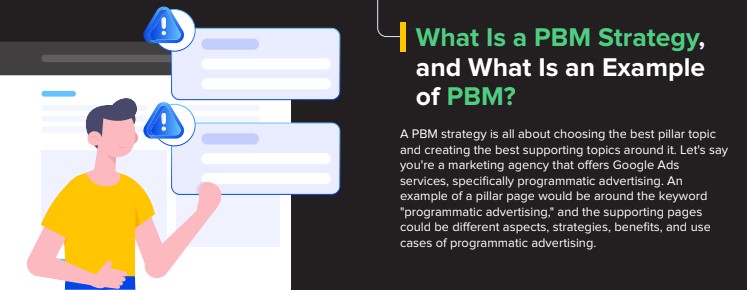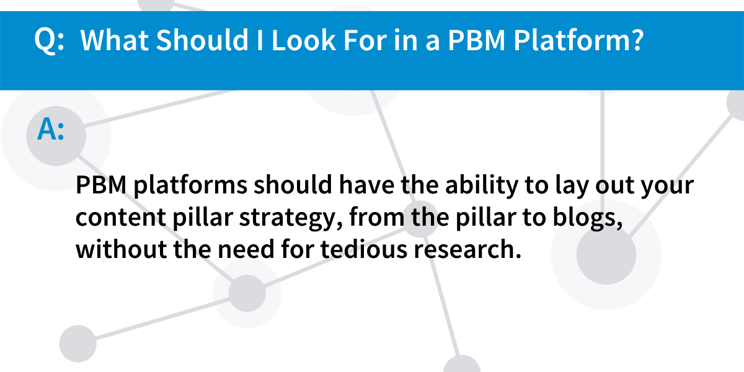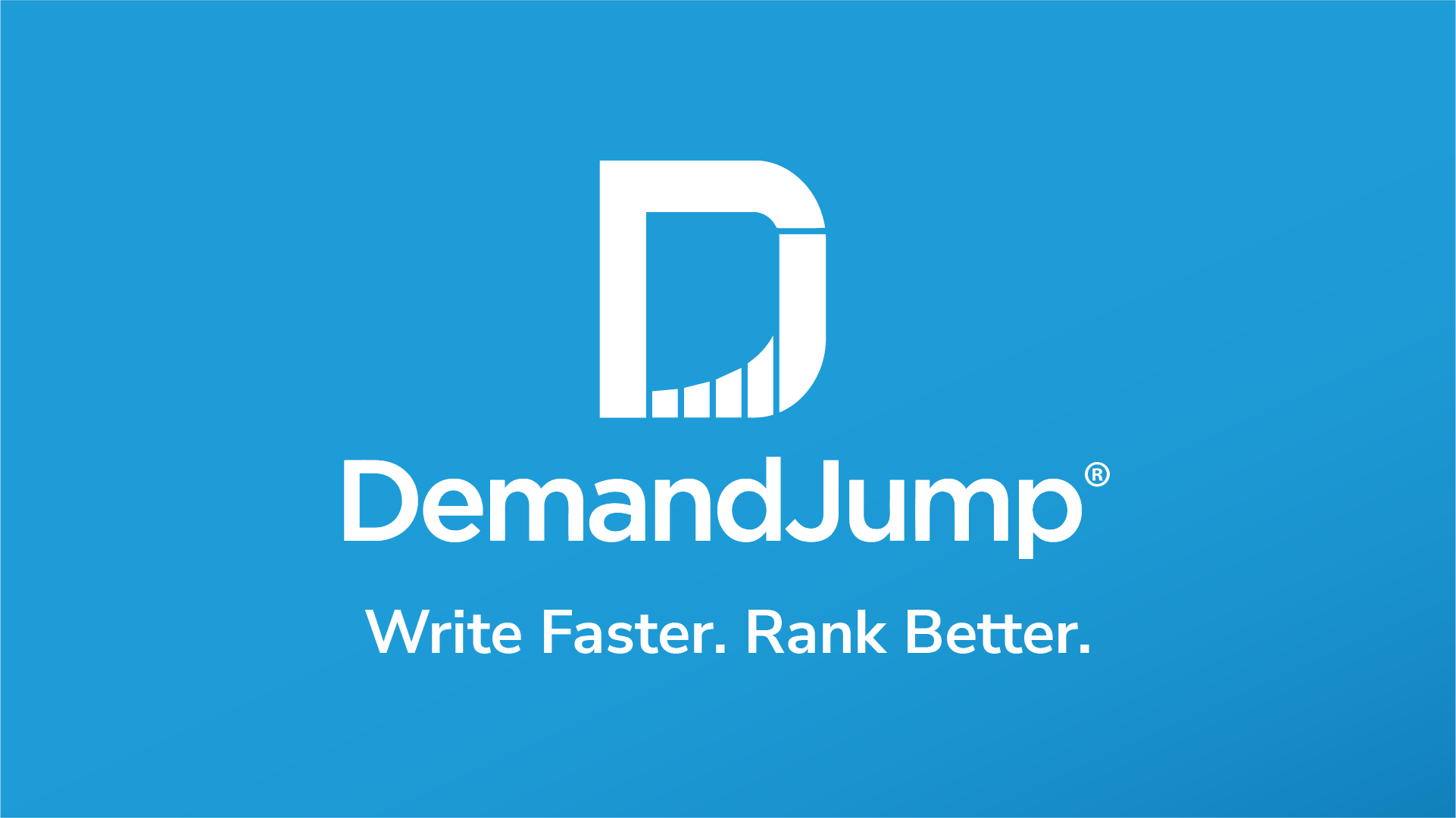When it comes to marketing online, it can be pretty difficult to find the right strategies. Do you work tirelessly on researching your competitors? Do you write blogs stuffed with keywords? These are pretty normal techniques that don’t get a lot of results. Of course, there are keyword tools that can help you determine which terms and phrases are the best for your content, but these often lack a solid foundation in marketing strategies. Not only that, but keyword stuffing is a way of the past and does nothing if your content lacks in, well… interesting content. That’s where Pillar-Based Marketing comes in to help you create strong content that gains organic web traffic to your site.
You might be asking “How does Pillar-Based Marketing work?” First, we don’t want to pull the wool over your eyes: DemandJump is the one and only PBM platform. This blog is focused on helping you understand PBM and what a PBM platform should offer (just in case we get some competition someday). We will discuss what PBM platforms are and provide a few Pillar-Based Marketing examples to help you understand why PBM platforms are the best decision for your business.
What Is PBM and How Does It Work?
Pillar-Based Marketing is a content creation strategy meant to boost SEO rankings on Google. Page one ranking is achieved using a tiered structure of content called pillars, sub-pillars, and supporting blogs. Writing content in this structure is called a content pillar, as each piece holds up the writing above it. A PBM content strategy should consist of at least 16 pieces of content.
- Pillar:
We sometimes refer to pillars as an “Ultimate Guide” to any particular topic. These are ~3,000-word pieces that contain 15-20 high-value keywords and phrases. While pillars remain rather broad, they are meant to cover important questions to help readers understand the topic.
- Sub-pillar:
A sub-pillar is a more focused piece of content that covers a part of a pillar. These are ~1,500-word pieces that contain 12-15 high-value keywords and phrases. Because sub-pillars hone in on a more specific aspect of the pillar, that gives the writer the opportunity to go into further detail regarding the topic.
- Supporting blog:
The shortest piece of content within the content pillar is a supporting blog. These are ~750-word pieces that contain 5-10 high-value keywords and phrases. Because blogs are short, they are very specific on different aspects covered in the sub-pillar.
Okay, so we’ve talked about PBM and what it is, but what does it look like in practice?
Imagine you’re a vinyl record company that presses records for artists with a small or medium audience. A good pillar topic would be broad, like “vinyl records.” We know, how in the world do you write content about such a huge topic? There’s so much to say! Thankfully you can answer the big questions in the pillar and get more specific with sub-pillars and blogs.
Once you’ve decided on your pillar of vinyl records, you can start a sub-pillar focused on “custom vinyl records.” Again, the topics seem endless, but you’re narrowing the scope of your pillar on a very specific part of the general topic. A “custom vinyl records” sub-pillar is different from a “history of vinyl records” sub-pillar. For the sake of the example, focusing on how vinyls can be customized will draw in a particular audience that is interested in the how and why of creating records.
Finally, a supporting blog could answer the specific question, “How much does it cost to make a custom record?” This is where you can take the time to thoroughly answer a specific question. In the grand scheme of things, this sounds pretty simple, right? Just imagine the wealth of content you will have when you combine these three pieces together.

So where do you begin? Pillar-Based Marketing can exist without a software platform to guide you through the process. You can build your own plan through research and writing, but a good foundation starts with access to a tailored pillar-based strategy. Let’s dive into how we define the PBM platform meaning and purpose.
What Is a PBM Platform?
A Pillar-Based Marketing platform is a tool used to create a content pillar strategy using insights and keyword research. By providing high-value keywords, phrases, and questions, a PBM platform will help you build a content pillar that focuses on what your target audience is actually searching for. This means a PBM platform is the most powerful tool to research and create content for your website.
What you don’t get with standard keyword research tools is the depth and understanding of your market share based on data-driven content marketing and marketing attribution. Of course, it’s easy to stuff keywords into content, but with a PBM platform, you can interpret the data to see what is working and what isn’t. If you aren’t ranking for certain keywords, you’ll know it. DemandJump’s PBM platform is powerful and gives you the ability to create content that will reach a larger audience than if you are just using keywords alone.
Once you decide to use a PBM platform, what should it provide you to make sure you get the most out of your content pillar strategy?
What Should I Look For in a PBM Platform?
PBM platforms should have the ability to lay out your content pillar strategy, from the pillar to blogs, without the need for tedious research.

Think of it like this: You want to write about your business’s focus, like vinyl records. You spend hours—possibly days—of research on your competitor’s sites guessing which keywords to use, hoping they’ll be high-value and rank high with SEO on Google. Then you have to come up with a plan to write 16 pieces of content for your PBM strategy. Once you put it all together, you have a strong, interconnected content pillar posted online. This will bring in traffic from Google, but your only real measure of success is whether or not people are signing up for your service or upgrading their plans. Figuring out how impactful your strategy was and how you stack up against your competition is difficult without any tools to guide you.
Sounds pretty complicated, right? Thankfully a good PBM platform will solve all of those issues. A solid platform will help you automatically:
- Crawl the internet for the highest-ranking keywords, phrases, and questions around your topic using insight reports.
- Develop a content pillar strategy from top to bottom.
- Create interesting and impactful content around your topic.
- Measure your success by showing current page rankings.
- Show your organic market share in comparison to your competitors.
With a good platform to build your PBM strategy, you will find success in your page rankings, organic traffic, and an increase in conversions. DemandJump gives you all of these features, so you can reach page one and beat out your competitors.
What Is the Best PBM Platform?
DemandJump is the best—and only—PBM platform, because we created this strategy! PBM is our bread and butter and we’ve developed a powerful platform to help ensure you meet your goals of being ranked higher in Google searches with stronger SEO content.
So if you’re asking “How do I choose a PBM platform?” The answer is quite simple: DemandJump will give you all of the tools necessary for Pillar-Based Marketing in one place without having to search the web and create content on your own.
Does PBM Cost Money?
No! Developing your own Pillar-Based Marketing framework does not cost money—at least not initially. Once you determine the pillar topic and relevant questions, you’ll be able to start your PBM journey. The only problem with taking on a PBM strategy by yourself is the amount of time and research it takes to get it right. The great thing is that with DemandJump’s free “For Discovery” plan you can try our PBM insights tools that do the hard work for you. With the free plan, you get unlimited access to insight reports, a comparison to three competitors and their rankings, and one content brief. This means you can successfully build your own PBM strategy template without the high costs of a keyword research tool.
Okay, so starting a PBM strategy is free, but what if you want to increase your website traffic even more? To build a stronger PBM strategy, you’ll want to upgrade to a DemandJump Plus, Premium, or Pro plan. Among many features, you’ll get access to unlimited content briefs, multiple users, and tailored content pillar strategies.
DemandJump: PBM Done Right
At DemandJump, we pride ourselves on being the best PBM platform, because we created it! We know the ins and outs of SEO research and content creation better than anyone. Our customers have seen great results by reaching page one on Google and seeing huge increases in capturing new customers.

It’s clear that with DemandJump, you get the best of PBM content creation with all of the benefits in one place. Our team is dedicated to making sure you get the most out of your content to reach page one!













